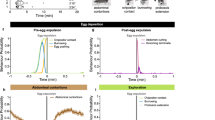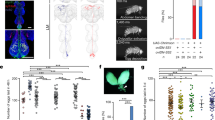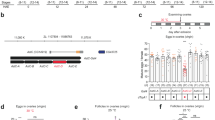Abstract
ODHIAMBO1 and Saunders and Dodd2 reported that the first fully developed egg in the tsetse fly (Glossina pallidipes1 and G. morsitans2) is not released from the ovary into the uterus until the female has had mating experience. They observed that the component of the mating act causing ovulation was not insemination, and suggested that a mechanical factor is responsible for the initiation of ovulation2. It is difficult to see how a strictly nervous mechanism could account for the time lag between mating and ovulation (females mated 2–3 d after emergence usually ovulate 6–7 d later). Foster3 found that the ablation of median neurosecretory cells (MNC) of the pars intercerebralis almost always inhibited ovulation in G. austeni. He noted, however, that surgical brain trauma also inhibited ovulation in control flies. Ejezie and Davey4 found that the MNC undergo cyclic changes of net synthesis and release in G. austeni and attempted to correlate these phenomena with ovulation and larviposition. We describe here investigations of the control mechanism of ovulation in G. morsitans morsitans.
This is a preview of subscription content, access via your institution
Access options
Subscribe to this journal
Receive 51 print issues and online access
$199.00 per year
only $3.90 per issue
Buy this article
- Purchase on Springer Link
- Instant access to full article PDF
Prices may be subject to local taxes which are calculated during checkout
Similar content being viewed by others
References
Odhiambo, T. R., J. exp. Zool., 177, 447–454 (1971).
Saunders, D. S., and Dodd, C. W. S., J. Insect Physiol., 18, 187–198 (1972).
Foster, W. A., Bull. ent. Res., 483–493 (1974).
Ejezie, G. C., and Davey, K. G., Bull. ent. Res., 64, 247–256 (1974).
Porter, R. W., Cavanaugh, E. B., Critchlow, B. V., and Sawer, C. H., Am. J. Physiol., 189, 145–151 (1957).
Author information
Authors and Affiliations
Rights and permissions
About this article
Cite this article
CHAUDHURY, M., DHADIALLA, T. Evidence of hormonal control of ovulation in tsetse flies. Nature 260, 243–244 (1976). https://doi.org/10.1038/260243a0
Received:
Accepted:
Issue Date:
DOI: https://doi.org/10.1038/260243a0
This article is cited by
-
10.1007/BF00333919
CrossRef Listing of Deleted DOIs (2011)
-
10.1007/BF00195577
CrossRef Listing of Deleted DOIs (2011)
-
Cyclic AMP is a likely mediator of ovulation in the tsetse fly
Experientia (1978)
Comments
By submitting a comment you agree to abide by our Terms and Community Guidelines. If you find something abusive or that does not comply with our terms or guidelines please flag it as inappropriate.



